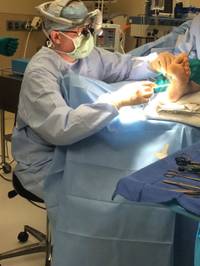Editor's note: This story was originally published in Health Care Quarterly, magazine about Southern Nevada's health care industry. Stories in Health Care Quarterly were submitted by doctors and their affiliates.
Pain is universal. It is a common link all people share, the root of empathy; it separates the good times from the bad times. Pain alerts our brains to danger and damage, thereby keeping us safe, helping us to learn from and alter bad behaviors. In many ways, pain is good.
Until it’s not.
We each know someone who experiences chronic pain, the result of disease or accident or the lingering side effect of surgery. One of the most likely causes is damage to the peripheral nervous system. Consisting of all of the nerves outside of the skull and bony spine, the peripheral nervous system is one of the largest and most poorly understood in the human body.
While surgeons (neuro, orthopedic, plastic, hand) have been operating on peripheral nerves for a long time, the approach, until very recently, has been fragmented at best. The typical course of study that leads doctors through their medical training includes only the most bare-bones basic instruction on the peripheral nervous system in medical school, and it is not revisited in any depth during a medical or surgical residency, or additional fellowship subspecialty training. Bits and pieces of what is actually peripheral nerve surgery have, over time, been incorporated into other specialties, usually out of necessity. Examples of this would be hand surgeons doing carpal tunnel surgery or orthopedic foot and ankle surgeons doing tarsal tunnel surgery.
When orthopedic surgeons operate to repair a crushed foot, their primary objective is to restore the function and form of the foot. They tend to focus on repairing bones, tendons and ligaments, which is their area of expertise. Although they are generally aware of large nerves important for motor function (muscle movement), they are typically unfamiliar with the many smaller nerves that transmit signals from the foot to the spine and then the brain, nerves that may be displaced, damaged or severed during the operation, if not the injury that preceded it.
It is only recently that the specialty of peripheral nerve surgery has developed to specifically treat pain problems related to the peripheral nervous system. Historically, the lion’s share of research in the field of peripheral nerve surgery has been devoted to solving functional problems — patients who have lost the ability to move an important muscle, group of muscles or an entire arm or leg. This includes research in the areas of better understanding the biology of nerve healing, the surgical techniques and technology involved in nerve repair, and more recently nerve transfers to try and restore functional deficits. While these types of injuries are obvious in their severity, they represent less than one percent of peripheral nerve pathology. The vast majority, the other 99 percent, manifest primarily as pain.
There are three main categories of surgically treatable nerve pain:
Nerve compression — the most commonly recognized form of nerve compression is carpal tunnel syndrome. This is essentially a situation where the nerve is being compressed or “pinched” by surrounding tissue.
Nerve stretching — when functioning properly, nerves glide through tissue and around joints as our bodies move. When a nerve becomes stuck in scar tissue, the nerve is stretched like a rubber band, rather than gliding back and forth, which can be very painful.
Neuroma formation — when a peripheral nerve is cut, it will try to regenerate and heal itself. The end of the nerve that is still attached to the spinal cord (the proximal end) will sprout new nerve fibers. The other end of the nerve (the distal end) will produce chemical signalers to try and guide the new growing nerve ends from the proximal part of the nerve so that it can reconnect. If this process is frustrated because a large piece of the nerve is missing or the proximal end of the nerve gets stuck in scar tissue, then a neuroma, a bulbous growth of sensitive nerve endings, will develop on the end of the proximal nerve. If this structure ends up in a place where it is being bumped or stretched or rubbed for whatever reason, the patient will often experience severe, unrelenting pain.
Western medicine’s traditional approach treats all pain as one homogenous entity. Pain medication has been the primary tool used to treat anyone in severe or chronic pain. The more pain a patient is in, the more pain medication is doled out, even when it fails to alleviate the pain. Unfortunately, for patients with peripheral nerve problems, traditional narcotic (Percocet, Lortab, Oxycontin, etc.) or “neuropathic” pain medications (Gabapentin/Neurotonin, Cymbalta, Lyrica) are usually quite ineffective at treating peripheral nerve-related pain. Although the exact mechanism of action of many of these drugs is not clearly understood, they all act to block the pain signal centrally in the brain or spinal cord. Unfortunately, peripheral nerve issues are primarily mechanical problems outside the brain and spinal cord where the nerve itself is damaged or compressed (pinched).
The other major practice in the treatment of peripheral pain, or pain occurring in arms, legs, torso or pelvis, is to attribute the cause of pain to a problem at the spinal cord or nerve root level. Because the central nervous system is most physicians’ primary suspect, treatment commences with the spine in the neck or lower back, usually without any investigation of the peripheral nerves — those between the spine and the site where the patient is experiencing pain – and many peripheral nerve problems can mimic an issue at the spine level. Misdiagnosed patients can undergo multiple rounds of spinal injections by pain management physicians and even spine surgery for what may ultimately have been a peripheral nerve problem.
Unfortunately, most of the commonly available imaging studies, such as MRIs, CT scans, X-rays and ultrasound, are essentially useless for directly pinpointing the location of compressed or damaged nerves in patients with peripheral nerve problems — nerve tissue does not appear on X-rays and most CT and MRI scanners are not sensitive enough to identify structures as small as most peripheral nerves. Even in cases where a larger nerve is identifiable, the images typically do not allow a radiologist to determine if the nerve is distressed and likely to be causing pain. There are now a few centers around the country utilizing MR Neurography — more powerful 3Tesla MRI machines and cutting edge mathematical algorithms to render the data that can locate more of these difficult-to-identify peripheral nerves. However, this type of imaging study is still not widely available.
Electrodiagnostic testing is also commonly used in attempts to diagnose peripheral nerve problems. While EMG (electromyography) and NCS (nerve conduction study) can be useful when they identify a pinched nerve, they may also fail to detect the problem altogether. In cases such as these, normal EMG/NCS results do not indicate that the problem is temporary, minor or imagined, but rather that the EMG/NCS has simply failed to detect the problem with the nerve(s) from an electrical standpoint. This is known as a “false negative” result. In patients with more complex peripheral nerve problems, it is unlikely that the EMG/NCS will identify all of the trouble nerves and is therefore of little use.
Due to the severe limitations associated with current imaging technology and electrodiagnostic studies, diagnosing peripheral nerve problems requires a combination of patient history and physical examination. Performing a comprehensive peripheral nerve examination requires a detailed understanding of peripheral nerve anatomy. In many situations, diagnostic blocks are also useful in determining which nerve(s) are signaling pain. A diagnostic block is simply done by injecting local anesthetic around the suspected nerve to “put it to sleep” and then seeing if the pain goes away. Patients with persistent extremity pain or weakness after spine surgery or in the face of ongoing spine pain with no obvious compressive lesion at the spine level should always have a peripheral nerve evaluation.
Peripheral nerve surgery can offer relief to patients suffering from a wide range of pain problems, previously without solutions, including: Nerve compression syndromes — these patients present with confusing pain syndromes that may involve partial or entire limbs; diabetic or idiopathic neuropathy; certain types of chronic or migraine headaches; phantom pain or stump pain in amputees; Meralgia paresthetica — compression of the lateral femoral cutaneous nerve which is a common painful condition affecting the thigh and hip area; reflex sympathetic dystrophy (RSD), now more commonly called chronic regional pain syndrome (CRPS); chronic joint pain; groin, pelvic or facial pain. With a history of prior traumatic injury or some type of surgical procedure, patients who continue to experience debilitating pain beyond six months should be considered to have peripheral nerve damage until proven otherwise.
It is the goal of peripheral nerve surgery to relieve pain — permanently and effectively — at its source. In pinpointing the specific, distressed nerve(s), we are now able to address severe peripheral nerve pain directly, eliminating the need for chronic pain medication or indwelling devices such as pain pumps and spinal cord stimulators.
For the vast majority of patients with true chronic peripheral nerve pain, peripheral nerve surgery offers the only real possibility for permanent pain relief.
Timothy W. Tollestrup, M.D., earned medical and master of public health degrees from the University of Utah. He completed his residency in general and trauma surgery at Saint Louis University Hospital, a fellowship in hand, reconstructive and microsurgery from Baylor College of Medicine and another in peripheral nerve surgery from the Dellon Institute of Peripheral Nerve Surgery. He is the only comprehensive peripheral nerve specialist focused on treating chronic nerve pain practicing west of the Mississippi.

